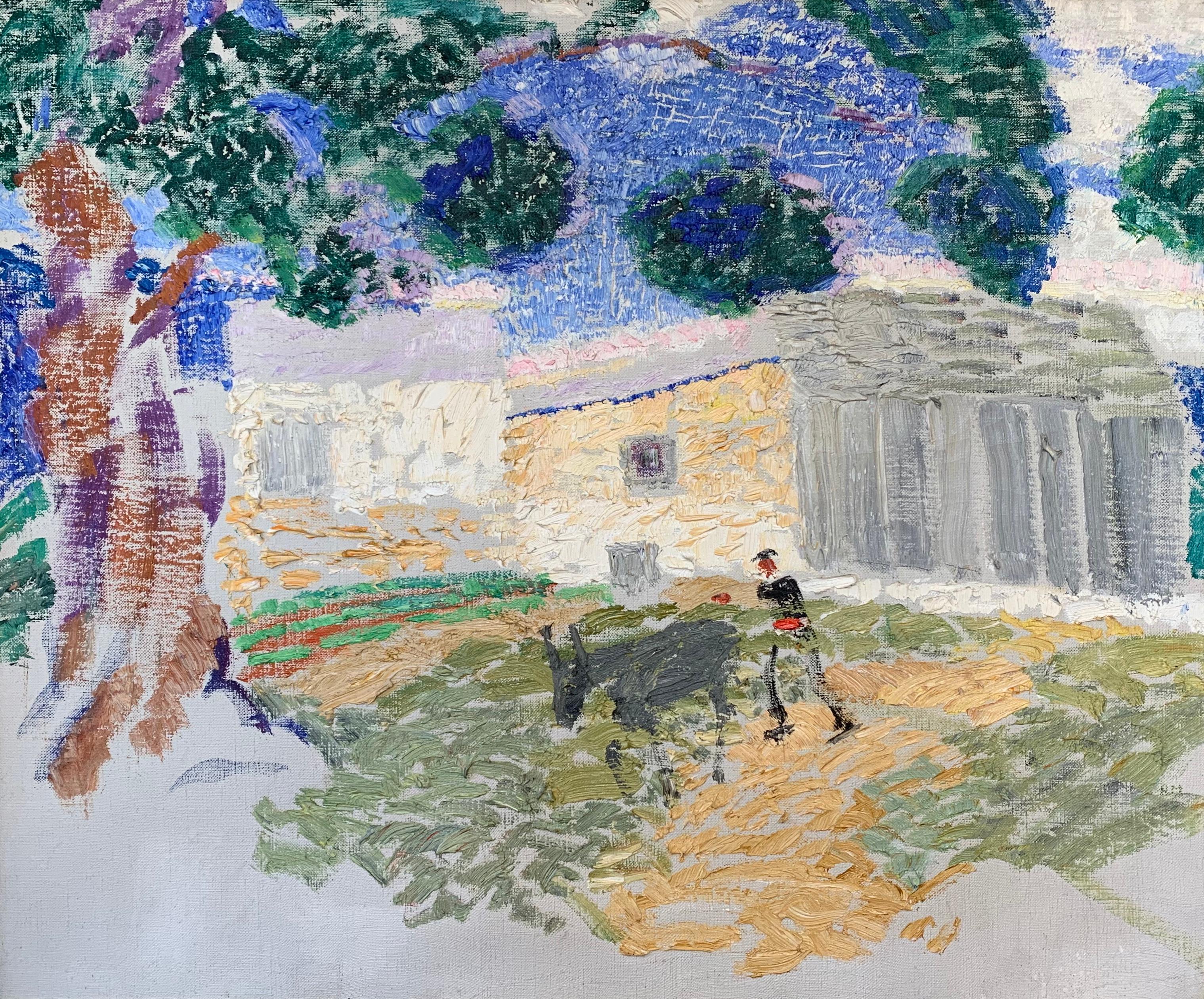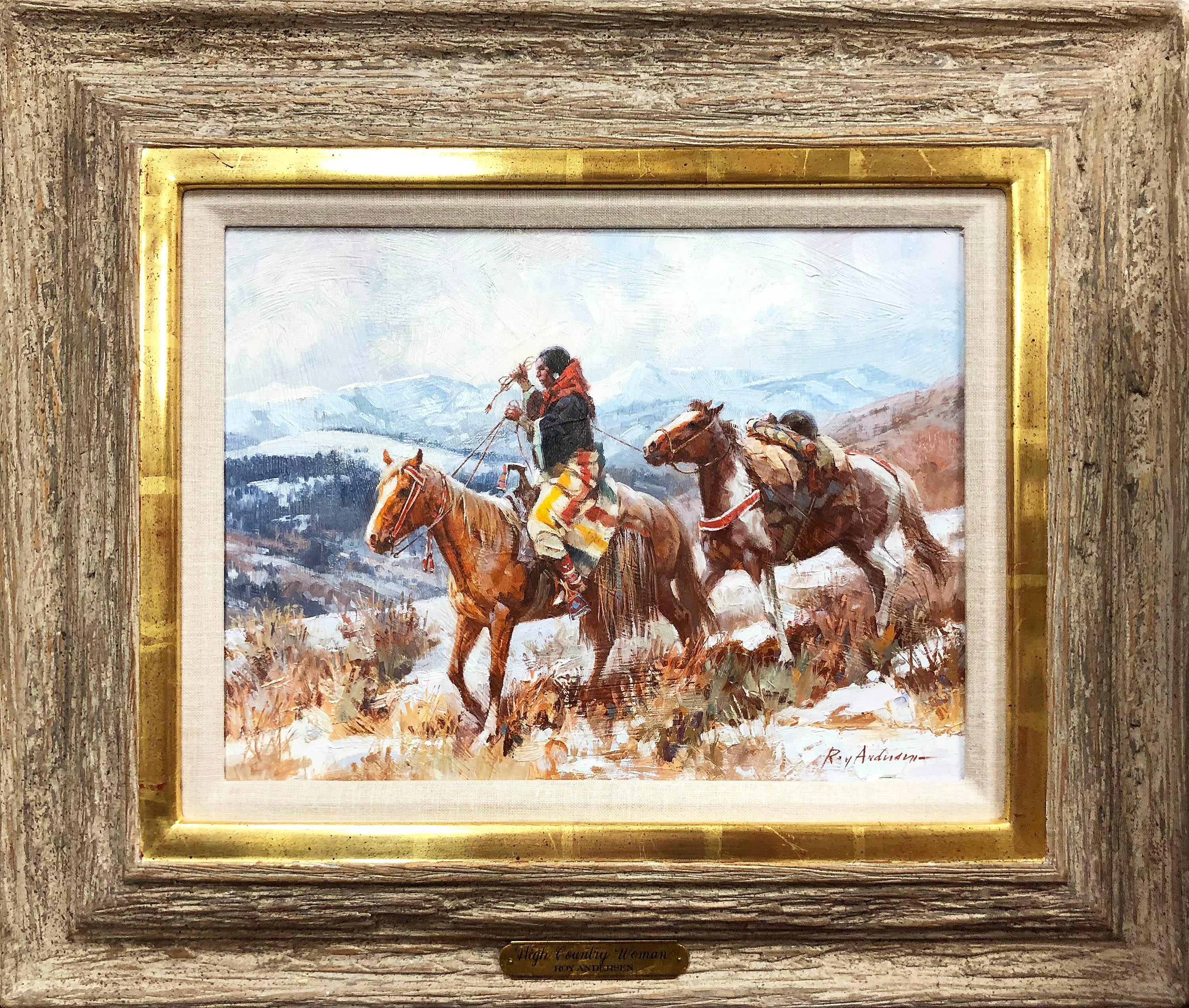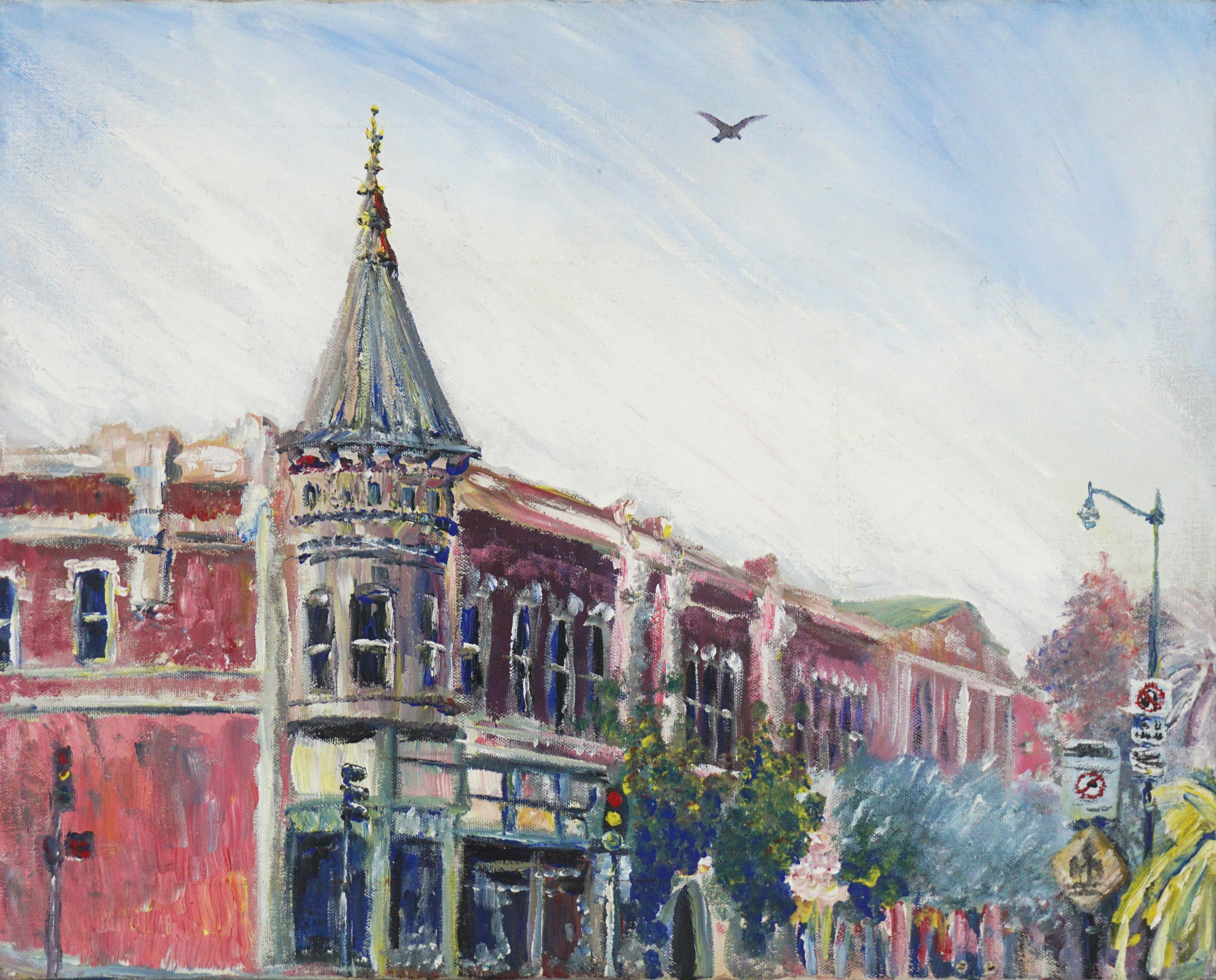Items Similar to Picnic Shade
Want more images or videos?
Request additional images or videos from the seller
1 of 2
Donald S. VogelPicnic Shade1981
1981
About the Item
Donald Vogel’s paintings reflect his interest in seeking beauty in life and in sharing pleasure with his viewers. Vogel entreats us to "rejoice and celebrate each new day, knowing it is a gift in itself, and produce something of worth to be shared. That is the life that has served this artist's pilgrimage."
Donald S. Vogel has been a set designer and technical director in the theater, a fine art dealer, and a writer, but first and foremost he is a painter. From a young age he was intrigued by the possibilities of creating images. The excitement and pleasure derived from the act of creation continued to be the force that compelled him to paint throughout his life.
Born in Milwaukee, Wisconsin, Donald S. Vogel began his formal art training at the Witte Memorial Museum in San Antonio when he was seventeen. His training, under the watchful eye of Eleanor Onderdonk, was briefly interrupted by a move to Washington, DC , where he took drawing classes at The Corcoran School of Art . He returned to San Antonio to finish high school and continued studying under Onderdonk. After graduation, he moved to Chicago in 1936 to enroll in The School of the Art Institute of Chicago. In the Impressionist and Post-Impressionist rooms of the Institute, a new world opened up to him, one that would forever influence the direction of his work. He saw art that dealt with the effects of atmosphere and light. The subjects and techniques used by these painters conveyed a sense of happiness, exuberance, and pleasure, which offered a stark contrast to the world outside stifled by the Great Depression.
While studying at the Art Institute, Vogel roomed at the Artist Community House where many students lived. This environment served as a counterpoint to the academic training he received at the Institute. It afforded the students the freedom to discuss issues in contemporary art, and freely experiment with unconventional ideas and techniques. Most importantly, this fertile environment intensified Vogel's commitment to paint.
Feeling the pinch of the Depression, Vogel left the Art Institute in 1940, and was accepted on the WPA Easel Project. This allowed him the luxury of drawing and painting from dawn to dusk. The freedom to paint at all hours focused his interest on the seemingly endless variations of light and atmosphere. With unlimited use of a model, he produced thousands of figure drawings until, eventually freed from the necessity of working from life, he began to paint purely from his imagination.
In 1942, Vogel moved to Dallas. The previous year, while he was still living in Chicago, the Dallas Museum of Fine Arts had given Vogel a one-person show; in 1943, shortly after his arrival in Dallas, the DMFA gave him another. While working first as a set designer and then as technical director at the Dallas Little Theater, Vogel spent his free time at the easel. During the 1940's he gained recognition in the art community by promoting the work of fellow artists and winning coveted purchase awards and prizes in the Texas General and Allied Arts Exhibitions for his own paintings.
In 1951, Vogel and his wife Peggy, alongside Dallas arts patron Betty McLean, opened the Betty McLean Gallery. It was the first gallery in Texas to deal in modern art on an international level. In 1954, the Vogels moved to a five-acre site north of Dallas and opened Valley House Gallery. The new setting at Valley House deeply inspired Vogel, serving as a source for ideas, and providing a place of serenity and contemplation.
Vogel's work is characterized by his love of color, and his fascination with the changing qualities of light. A favorite subject, often revisited during the latter part of his career, is the greenhouse. He first experimented with this subject in 1976, and began using it in earnest in 1978. Having worked in a hothouse during his youth, he found it a natural subject for exploring the effects of atmosphere, light, and color. Like Monet's pond at Giverny, Vogel's greenhouses have become his signature: an imaginary place of endless fascination.
Vogel produced many catalogues for gallery artists but he had never written for himself. In 1989, he penned two autobiographical short stories and published them under the title Charcoal and Cadmium Red. He found writing to be as challenging a process as painting. During his eighth decade, he wrote and painted with equal intensity.
“The agony and ecstasy I felt while producing each work was welcomed, as each required the other to fulfill the quest. And the quest remains to produce works that should delight the eye, give pause for thought, heighten the spirit, and sense the awareness of our being,” wrote Donald S. Vogel in 1998, on the occasion of his Retrospective exhibition and catalogue.
Donald S. Vogel's work is included in the following collections:
Art Institute of Chicago, Chicago, Illinois
Beaumont Museum of Fine Art, Beaumont, Texas
Charles Goddard Center, Ardmore, Oklahoma
Dallas Museum of Art, Dallas, Texas
Fine Arts Museum of the South, Mobile, Alabama
Ft. Worth Art Association, Ft. Worth, Texas
Old Jail Foundation, Albany, Texas
Panhandle-Plains Historical Museum, Canyon, Texas
Philadelphia Museum of Art, Philadelphia, Pennsylvania
Philbrook Art Center, Tulsa, Oklahoma
The Pennsylvania Trust, Radnor, Pennsylvania
Tyler Museum of Art, Tyler, Texas
Witte Museum, San Antonio, Texas
- Creator:Donald S. Vogel (1917-2004, American)
- Creation Year:1981
- Dimensions:Height: 70 in (177.8 cm)Width: 80 in (203.2 cm)
- Medium:
- Movement & Style:
- Period:
- Condition:
- Gallery Location:Dallas, TX
- Reference Number:
About the Seller
5.0
Recognized Seller
These prestigious sellers are industry leaders and represent the highest echelon for item quality and design.
Established in 1954
1stDibs seller since 2013
151 sales on 1stDibs
Typical response time: A week
Associations
Art Dealers Association of America
- ShippingRetrieving quote...Ships From: Dallas, TX
- Return PolicyA return for this item may be initiated within 2 days of delivery.
More From This SellerView All
- Garden WalkBy Donald S. VogelLocated in Dallas, TXDonald S. Vogel has been a set designer and technical director in the theater, a fine art dealer, and a writer, but first and foremost he is a painter. From a young age he was intrig...Category
Late 20th Century American Impressionist Figurative Paintings
MaterialsOil, Panel
- Figure in GardenBy Donald S. VogelLocated in Dallas, TXDonald Vogel’s paintings reflect his interest in seeking beauty in life and in sharing pleasure with his viewers. Vogel entreats us to "rejoice and celebrate each new day, knowing it...Category
1980s American Impressionist Figurative Paintings
MaterialsOil, Panel
- Shaded PathBy Donald S. VogelLocated in Dallas, TXDonald Vogel was inspired by gardens throughout his painting career. Before moving to Dallas, as a student at the Art Institute of Chicago in the late 1930's, Vogel's studio was a block away from Chicago's Lincoln Park...Category
1980s American Impressionist Figurative Paintings
MaterialsOil, Panel
- The Blind WomanBy Miles Cleveland GoodwinLocated in Dallas, TX"The Blind Woman" by artist Miles Cleveland Goodwin is oil on canvas, and measures 72 5/8 x 44 5/8 inches. Including the artist-made frame, the overall dimensions are 74 1/8 x 46 1/8...Category
2010s Realist Landscape Paintings
MaterialsOil, Canvas
- Scattering AshesBy Miles Cleveland GoodwinLocated in Dallas, TXIn Hyperallergic (April 8, 2017) Edward M. Gómez writes of Miles Cleveland Goodwin, his "portraits and images of nature or people in nature... capture moments of heightened awareness...Category
2010s Contemporary Figurative Paintings
MaterialsCanvas, Oil
- AnxietyBy Valton TylerLocated in Dallas, TXIn The New York Times Arts in America column, Edward M. Gomez wrote of Valton Tyler: Visionary seems the right word for describing his vivid, unusual and technically refined painting...Category
1980s Surrealist Figurative Paintings
MaterialsCanvas, Oil
You May Also Like
- Plowing the Fields, American Impressionist Landscape with Figure and AnimalBy Henry McCarterLocated in Doylestown, PA"Plowing the Fields" is an early 20th Century American Impressionist landscape by Pennsylvania Academy graduate and teacher Henry McCarter. The 20" x 24...Category
Early 20th Century American Impressionist Landscape Paintings
MaterialsCanvas, Oil
- Young Lady Picking WildflowersBy Charles Bosseron ChambersLocated in Missouri, MOCharles Chambers (American, 1880-1964) Young Lady Picking Wildflowers Signed Lower Right 10 x 13 inches 16.5 x 16.5 inches with frame C. Bosseron Chambers was known for figurative works in an illustrative manner, with many of them being either portraits or works with religious themes. An illustrator and teacher as well as painter, Chambers was born in St. Louis, Missouri on May 1882. His father, a young Irish captain in the British Army, was a convert to the Catholic Church, and his mother was the daughter of a French family long established in St. Louis. Charles, the youngest of several children, was sent to the Preparatory and Grammar Schools connected with St. Louis University in his earliest years, and his education in his chosen art was begun under Louis Schultz of the Berlin Royal Academy, with whom he spent six years. His next master was Aleis Hrdliczka of the Royal Academy of Vienna, and he later studied with Johannes Schumacher of Dresden for six years. After matriculating at St. Louis University, Chambers began his professional career at Palm Beach, Florida, a place chosen because of his mother's failing health. From this period in his artistic productions date the fantastic figure compositions exhibited at the St. Louis Exposition, together with portraits of Colonel Mitchell for the Missouri Historical Society; Joseph Jefferson, the great American actor; young Master Haven; Henry Phipps; Henry M. Flagler; Mrs. Voorhis and others. In 1916, he moved to New York City, and established himself in the Carnegie Studios, Carnegie Hall, where he occupied a splendid atelier. Here he produced the Light of the World, the most popular religious painting of the early 1900s in the USA. He was a member of the Society of Illustrators, established in 1901 in New York City, and the Salmagundi Club, an early important art club in New York City. He illustrated Sir Walter Scott's, Quentin Durward, in the Scribner Classics for Young People. His work was exhibited at the well-known John Levy Galleries in New York City in the 1930s, and his work is now in several public collections in St. Louis and Chicago, including Chicago's St. Ignatius's Church, Missouri Historical Society in St. Louis, and the Osceola Club in St. Augustine, Florida. Chambers is listed on p. 145 of Currier's Price Guide to American Artists at Auction, 6th ed. 1994, written & compiled by William T. Currier, Currier Publication, Stoneham, MA. Reviews of his artwork have appeared in various publications, including the following: "Chambers' Seven Dolors criticized by Emily Genauer" Art Digest v. 13 March 15, 1939, p. 58. "From Angels to men: Recent portraits, John Levy Galleries" Art Digest v. 10 Nov. 15, 1935, p. 12. "Exhibition, John Levy Galleries" Art News...Category
20th Century American Impressionist Figurative Paintings
MaterialsOil, Canvas
- Summer IdleBy Edward CucuelLocated in Missouri, MOEdward Cucuel (American, 1875-1954) Summer Idle, 1918 Signed Lower Right 35 x 43 inches 43 x 51 inches with frame Born in San Francisco, Edward Cucuel was an Impressionist painter o...Category
1910s American Impressionist Figurative Paintings
MaterialsOil, Canvas
- Old High Country WomanBy Roy AndersenLocated in Missouri, MORoy Andersen (b. 1930) "Old High Country Woman" Oil on Canvas 12 x 16 inches 21.5 x 25 inches framed Known as a western painter, Roy Andersen did paintings of Crow, Cheyenne, and Apache Indians. He began his career living in Chicago and New York and working as an illustrator. He did numerous covers for Time Magazine including portraits of Albert Einstein and Prince Fahd. He also did illustrations for National Geographic magazine, and did a stamp series on Dogs and American Horses, and in 1984 and 1985, won Stamp of the Year Award. As a muralist, he has filled commissions for the National Park Service, the Royal Saudi Naval Headquarters, and the E.E. Fogelson Vistor Center at Pecos National Monument in New Mexico. To pursue his talent for painting, Roy Anderson went West, living in Arizona and settling in Cave Creek. In 1990, he was voted official artist for Scottsdale's Parada del Sol, the "world's largest" horse-drawn parade commemorating the Old West. Andersen grew up on an apple farm in New Hampshire and learned about Indian customs from his many hours spent at the Chicago Museum of Natural History. He is meticulous about being historically accurate in his paintings. Of him it was written: "There are no 'happy accidents' in an Andersen painting. He has a knowledge of his subject that is attained only through extensive research. You will not find an Apache medicine bag...Category
Late 20th Century American Impressionist Figurative Paintings
MaterialsCanvas, Oil
- The Avenue Lights (5th Avenue, New York City)By Gerald Harvey JonesLocated in Missouri, MOThe Avenue Lights (5th Avenue, New York City) By. Gerald Harvey Jones (American, 1933-2017) Signed Lower Left 20 x 16 inches without frame 30.5 x 26.5 inches with frame G. Harvey (G...Category
20th Century American Impressionist Figurative Paintings
MaterialsCanvas, Oil
- Vintage Downtown Los Gatos, California Street SceneLocated in Soquel, CACharming vintage oil painting of the iconic La Canada Building on the corner of North Santa Cruz Ave and W. Main Street in downtown Los Gatos, California by ...Category
1980s American Impressionist Landscape Paintings
MaterialsCanvas, Oil



